Asteraceae -The Aster Family
Argurably the largest family of flowering plants worldwide, the aster family is composed of approximately 1100 genera and 25,000 Species. Generic relationships in the family are in a state of flux. The family was formerly known as the Compisiteae and is commonly know as the composite, aster, or sunflower family. In the Asteraceae the flower head consists of many smaller flowers. Due to the complexity of the Asteraceae generic arrangemnet is difficult. Divisions of the aster family in scientific and/or common use include: subfamilies, tribes, artificial divisions, and genera. In this guide tribes are to collect similiar genera. All flowers are classified by their morphology (the form of the flower). Unfortunately many features are "cryptic"; not immediately obvious open examination with the naked eye. Examples of cryptic features include DNA sequences and microscopic forms of the pollen grains. Hence a guide based on observation of external features attempts to correlate those features evident from visual observation with the underlying cryptic features which often determine the genera and species.
The common Asterace Tribes occuring the southwestern us are included below. A typical member of each Asteraceae Tribe is illustrated. Links to the genera contained in the Tribe are provided. Each genera subsequently links to the species contained in the genera. Notes regarding both cryptic and visual characteristics are included for each tribe, genera, and species.
Anthemideae Camomile Tribe |
Achillea |
millefolium |  |
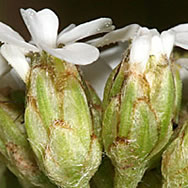 |
 |
Example: Achillea millefolium Western Yarrow |
 |
 |
 |
|
| The Anthimideae include the common, white flowered Western Yarrow illustrated above, and the ubiquitous sages so characteristic of the mountian west. The most common sage is Artemisia tridentata, Big Sage. Anthimideae flowers are often rather small. The flowers have no pappus and the phyllaries are rather papery or "scarious" in several overlapping series. | ||||
Example: Erigeron Divergens Spreading Erigeron |
 |
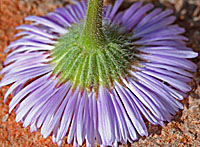 |
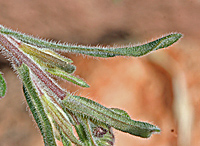 |
|
| Aster means star. The Astereae form a large tribe of flowers common throughout the southwest. Many rather weedy species are asters. Asters typically have numerous ray and disk flowers. Leaves are usually alternate. The pappus is usually composed of bristles. Phyllaries are in several unequal series. Cryptic characters include anthers with blunt bases, epaleae receptacles, and flattened stigmas with marginal rows of papillae. | ||||
Taraxacum officinale Common Dandelion |
 |
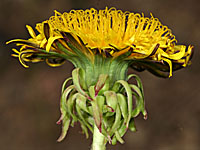 |
 |
|
| Cichorieae is derived from the Greek kicohore, meaning chicory. Chicory , dandelion (Taraxacum), Salisfy (Tragapogon), and many genera similar in appearance to these are members of the Dandelion Tribe. In Cichorieae only ray flowers are present and the plants usually have milky sap. | ||||
Example: Cirsium undulatum Wavyleaf Thistle |
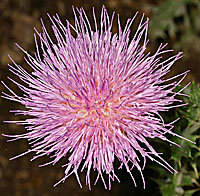 |
 |
 |
|
| Cynareae is derived from the Greek kuon, meaning dog. The phyllaries in the Cynareae are said to resemble dogs teeth. Cirisium and Carduus, genera containing thistles and Centaurea, the invasive knapweeds, are members of the Cynareae. Thistle tribe members are typically spiny or prickly, have only disk flowers, and possess leaves with divided edges. | ||||
Example: Brickellia grandiflora Brickellia |
 |
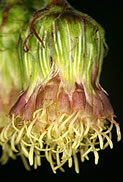 |
 |
|
| Eupatoreae is derived from the name of the Greek King Eupator who discovered a poision antidote in one of the species. Brickellia and Gayfeather (Liatris) are members of the Eupatoreae. Bonset Tribe members have only disk flowers and opposite leaves. Cryptic chacters include anthers with blunt edges. | ||||
Example: Antennaria rosea Rosy Pussytoes |
 |
 |
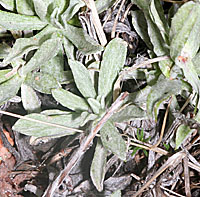 |
|
| Gnaphalieae is derived from the Greek gnaphalion, a plant with soft white leaves. Pussytoes (Antennaria) and Pearly Everlasting (Anaphalis) are members of the Gnaphalieae. Characteristics of the Everlasting Tribe include wooly leaves with entire margins, heads of disk flowers, and white or brightly colored phyllaries. Cryptic characters include a pappus of barbellate or plumose bristles. | ||||
Example: Helenium Hoopsei Orange Sneezeweed |
 |
 |
 |
|
| Helenieae is dervied from Helen of Troy. They closely resemble members of the Heliantheae but often have a pappus of scales rather than awns. | ||||
Example: Helianthus annus Annual Sunflower |
 |
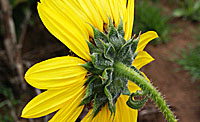 |
 |
|
| Helianthus comes from the Greek helios, or sun. The Heliantheae are the classic composites, rivaled in this respect only by the Astereae. Many genera similiar in appearance to the ubiquitous sunflowers are Heliantheae. Sunflower Tribe members have both ray and disk flowers and leaves are often opposite. The pappus is usually composed of awns and is not hairy. Cryptic characters include style branch appendages which are papillate to hispidulous. | ||||
Example: Senecio eremophyllus Cutleaf Senecio |
 |
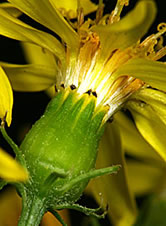 |
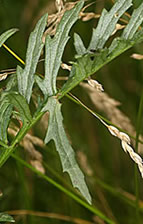 |
|
| Senecio is derived from the Greek "old man", referring to the pappus of abundent white bristles or hairs. Senecios are ubiquitous "damn yellow composites" of moderate to high elevations. The flowers usually are composed of yellow ray and disk flowers and have a somewhat ragged appearance compared to the more regular Heliantheae. Groundsel Tribe members have a pappus of white, silky hairs. More cryptic characters include style branch appendages which are absent or papillate. | ||||
| Mutiseae | Example: Trixis Californica |  |
 |
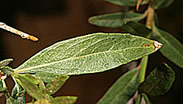  |